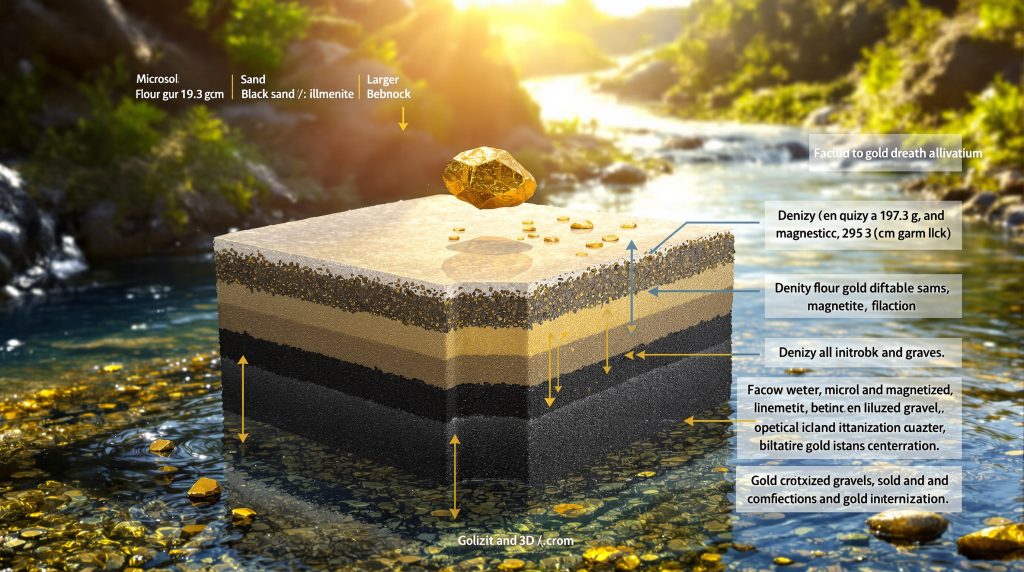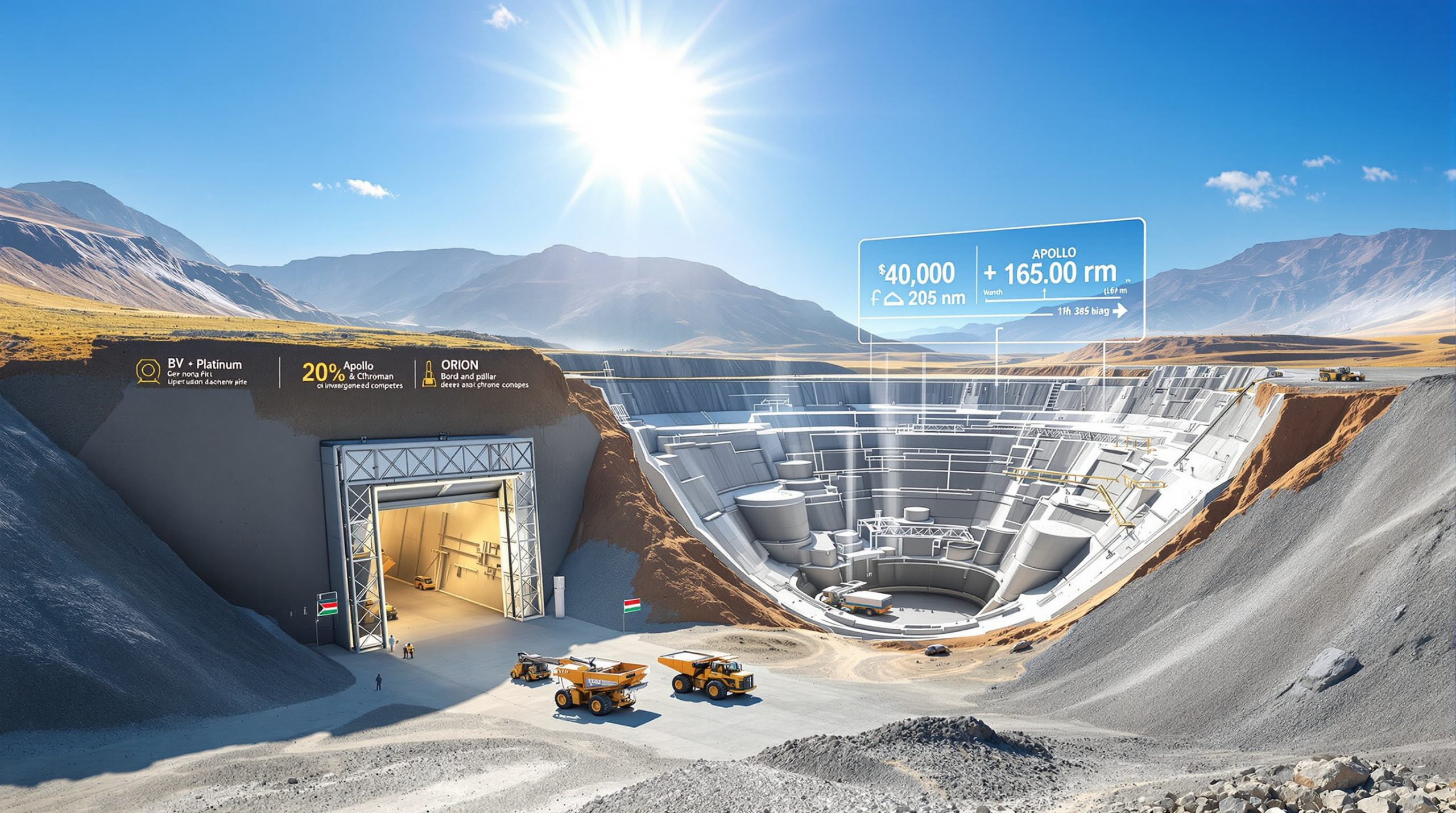Understanding Gold-Bearing Alluvium: Nature, Formation, and Mining Potential
Gold-bearing alluvium represents one of the most significant sources of placer gold worldwide. These natural deposits consist of unconsolidated sediments including gravel, sand, silt, and clay containing gold particles or nuggets that have been transported and deposited by flowing water. Formed when primary gold deposits erode, these particles accumulate in river systems through complex natural processes that concentrate this precious metal.
The geological processes that create these deposits leverage gold's exceptional physical properties – particularly its resistance to chemical weathering and remarkable density (19.3 g/cm³) – which cause it to behave differently from lighter minerals during water transport. When water velocity decreases, gold particles quickly settle in natural traps like stream bends, bedrock depressions, and areas behind large boulders.
Key Characteristics of Gold-Bearing Alluvium
Gold-bearing alluvium displays several distinctive characteristics that make it recognizable to experienced prospectors:
- Sediment Composition: A heterogeneous mixture of various-sized materials ranging from fine clay to substantial boulders
- Gold Forms: Occurs in multiple forms from microscopic "flour gold" to substantial nuggets
- Formation Environment: Develops in diverse settings including rivers, streams, flood plains, terraces, and ancient channels
- Concentration Mechanism: Gold particles concentrate in specific locations due to their exceptional density (19.3 g/cm³)
- Associated Minerals: Typically contains "black sands" (magnetite, ilmenite, garnet, zircon) which serve as visual indicators
How Gold Concentrates in Alluvial Deposits
The extreme density difference between gold (19.3 g/cm³) and common minerals like quartz (2.65 g/cm³) creates distinctive sorting patterns. This fundamental physical property explains why gold behaves differently during water transport:
- Gold settles rapidly when water velocity decreases
- Particles accumulate in natural riffles and stream bends
- Gold becomes trapped in cracks and depressions in bedrock
- Concentration occurs in low-energy zones where current slows
- Repeated flood cycles enhance this natural concentration process
How Does Gold-Bearing Alluvium Form?
The formation of gold-bearing alluvium involves multiple geological stages that transform gold from its primary source to concentrated deposits in river sediments. This process operates over vast timescales, sometimes millions of years, gradually concentrating gold into economically viable deposits.
1. Weathering of Primary Gold Sources
Primary gold deposits typically exist in these geological contexts:
- Quartz veins in bedrock
- Sulfide-rich deposits
- Mineralized zones in igneous or metamorphic rocks
Over extensive geological timeframes, these gold deposits analysis undergo:
- Physical breakdown from temperature fluctuations (freeze-thaw cycles)
- Chemical weathering from rainfall and groundwater infiltration
- Oxidation processes that decompose surrounding minerals and matrix
While most minerals deteriorate during these weathering processes, gold remains chemically stable and intact due to its noble metal properties. This resistance to chemical alteration ensures gold eventually becomes liberated from its host rock as surrounding materials break down.
2. Erosion and Transportation Processes
Once freed from bedrock, gold particles move downslope through various mechanisms:
- Gravity-driven movement (mass wasting)
- Surface runoff during rainfall events
- Stream and river transport systems
The transportation distance significantly affects gold characteristics:
- Nearby sources produce angular, coarse gold with minimal shape alteration
- Distant sources yield rounded, flattened particles from mechanical abrasion
- Extended transport creates fine "flour gold" as larger particles fragment
River systems play a crucial role in this stage, acting as natural conveyor belts that move gold particles from their source areas to depositional environments downstream.
3. Natural Sorting and Concentration
Rivers naturally sort materials by density and size through hydraulic processes:
- Lighter minerals remain suspended longer in flowing water
- Heavier minerals (including gold) settle quickly when water velocity decreases
- Repeated flood events enhance this concentration effect
This hydraulic sorting creates naturally enriched zones where gold becomes economically viable to extract. The extreme density difference between gold and common rock-forming minerals (quartz, feldspar) drives this process, creating natural concentration mechanisms that humans have exploited throughout history.
4. Deposition in Various Environments
Gold-bearing alluvium forms in multiple depositional settings, each creating distinctive placer types:
- Active stream channels: Where current velocity changes create natural traps for gold
- Flood plains: Where overbank flooding spreads fine gold across wide areas
- Terraces: Ancient riverbeds preserved above current water levels due to downcutting
- Deltas and beaches: Where rivers enter larger bodies of water, creating specialized deposits
These varied depositional environments create different types of placer deposits with unique characteristics that influence their mining potential.
5. Long-Term Geological Evolution
Over thousands to millions of years, river systems continue to evolve:
- Channels migrate and cut new paths
- Old deposits become reworked by subsequent erosional cycles
- Multiple episodes of erosion and redeposition occur
This long-term evolution explains why some of history's richest placer deposits (California, Klondike, Victoria) formed through repeated processing of gold-bearing materials. Each cycle potentially enhances gold concentration, creating increasingly enriched deposits over geological time.
What Are The Main Types of Gold-Bearing Alluvium?
Gold-bearing alluvium exists in several distinct forms, each with unique characteristics and formation processes that influence their mining potential and accessibility.
Stream Channel Placers
Characteristics:
- Form within active river or creek beds where water flows regularly
- Contain coarse gold, including nuggets and substantial flakes
- Gold concentrates in natural traps (riffles, potholes, behind obstacles)
- Historically triggered many famous gold rushes worldwide
Formation Factors:
- Riverbed morphology creates natural concentration points
- Bedrock irregularities trap heavier particles during transport
- Water velocity variations cause differential settling of gold and lighter materials
Stream channel placers remain among the most accessible placer deposits, allowing prospectors to recover gold using simple equipment like pans and sluices.
Flood Plain Placers
Characteristics:
- Develop when rivers overflow their banks during high-water events
- Contain primarily fine gold (small flakes and dust)
- Gold dispersed more widely than in channel deposits
- Cover extensive areas with lower average concentration
Formation Factors:
- Low-gradient meandering rivers spread sediments across wide floodplains
- Reduced water velocity during flooding allows fine gold to settle
- Multiple flood events build up gold-bearing layers over time
Flood plain placers often require larger-scale operations to process the extensive, lower-grade material efficiently.
Terrace and Bench Placers
Characteristics:
- Ancient riverbeds preserved above current water levels
- May contain both coarse and fine gold in concentrated layers
- Often cemented into consolidated gravel layers
- Require excavation rather than simple in-stream panning
Formation Factors:
- Rivers cut deeper channels over time, abandoning older beds
- Preserved "fossil placers" remain elevated on valley sides
- Geological uplift or river downcutting creates elevation differences
Terrace placers often contain exceptionally rich deposits since they represent ancient stream channels that may have undergone multiple concentration cycles before being abandoned.
Deltaic and Estuarine Placers
Characteristics:
- Form where rivers meet larger bodies of water (lakes, seas, oceans)
- Typically contain fine-grained gold due to extended transport
- Wave action and currents further sort materials by density
- Often mixed with marine or lake sediments
Formation Factors:
- Reduced water velocity at river mouths allows gold to settle
- Waves and currents rework and concentrate heavy minerals
- Shoreline processes create distinctive sorting patterns
These deposits sometimes create extensive beach placers that can be worked along modern or ancient shorelines.
Eluvial Deposits (Slope Placers)
Characteristics:
- Form on hillsides near primary gold sources
- Often contain coarse, angular gold with minimal transport
- Minimal transport distance from original source
- Serve as indicators of nearby hard rock deposits
Formation Factors:
- Weathering releases gold from outcrops and exposed veins
- Gravity moves particles downslope with minimal water transport
- Limited sorting compared to river-transported deposits
Eluvial deposits often provide clues to undiscovered primary gold deposits in the vicinity.
Glacial and Outwash Placers
Characteristics:
- Occur in regions previously covered by glaciers
- Contain mixed-size gold particles with variable sorting
- Often irregular in distribution and concentration
- Associated with distinctive glacial landforms
Formation Factors:
- Glaciers erode gold-bearing rocks during advance
- Meltwater reworks and concentrates gold particles during retreat
- Complex depositional patterns follow glacial retreat phases
Glacial gold deposits are common in northern regions like Alaska, Canada, and Siberia where continental ice sheets once covered gold-bearing terrain.
What Are The Key Properties of Gold-Bearing Alluvium?
Understanding the physical and geological properties of gold-bearing alluvium helps prospectors and mining operations identify and extract gold efficiently.
Composition and Mineralogy
Gold-bearing alluvium contains a distinctive mix of materials:
- Primary Components: Gravel, sand, silt, clay in varying proportions depending on depositional environment
- Gold Content: Ranges from microscopic particles to substantial nuggets
- Heavy Mineral Assemblage: Magnetite, hematite, garnet, zircon, ilmenite (collectively known as "black sands")
- Indicator Minerals: Certain minerals signal potential gold presence based on similar source areas
The ratio of these components varies significantly by location and affects both gold concentration and recovery methods. The presence of certain indicator minerals often guides prospectors to productive areas.
Sediment Structure and Stratification
Vertical Distribution:
- Gold typically concentrates near the bottom of alluvial sequences due to its high density
- "Pay streaks" form at the bedrock interface or above impermeable clay layers ("false bedrock")
- Multiple gold-bearing horizons may exist in complex deposits with several depositional cycles
Lateral Distribution:
- Richest concentrations follow ancient channel paths and natural traps
- Gold content varies dramatically across short distances, creating challenges for sampling
- Understanding paleochannel geometry proves crucial for exploration success
This structured distribution means that successful mining operations must understand both the vertical and horizontal patterns of gold concentration.
Gold Particle Characteristics
Size Variation:
- Nuggets (>4mm): Highest value, easiest recovery, often retain crystalline features
- Coarse gold (1-4mm): Visible to naked eye, recoverable by simple methods
- Fine gold (0.1-1mm): Requires more sophisticated recovery techniques
- Flour gold (<0.1mm): Challenging to recover, requires specialized equipment
Morphology:
- Shape indicates transport distance (angular vs. rounded particles)
- Flatness increases with transport distance as particles are hammered by water action
- Surface features reveal geological history and transport mechanisms
Purity:
- Alluvial gold typically purer than primary source gold due to natural refining
- Natural weathering removes silver and base metals from alloys
- Fineness often reaches 850-950 parts per thousand (compared to 750-850 in primary deposits)
These characteristics provide valuable information about the deposit's formation history and optimal recovery methods.
Hydraulic Behavior and Density Effects
The extreme density difference between gold (19.3 g/cm³) and common minerals like quartz (2.65 g/cm³) creates predictable patterns:
- Rapid settling of gold particles when water velocity decreases
- Concentration in natural traps and low-energy environments
- Distinctive sorting patterns visible in vertical profiles
- Predictable accumulation points in stream systems
Miners leverage these natural physical properties in both prospecting and recovery operations.
Economic Factors
The economic viability of gold-bearing alluvium depends on several interrelated factors:
- Grade: Gold concentration (measured in grams per cubic meter or milligrams per cubic meter)
- Volume: Total amount of gold-bearing material available for processing
- Accessibility: Depth, overburden, and mining conditions affecting extraction costs
- Particle Size Distribution: Affects recovery methods and overall recovery percentage
- Processing Requirements: Simple gravity separation vs. complex recovery technologies
These factors combine to determine whether a deposit can be profitably mined using available technology.
How Is Gold-Bearing Alluvium Mined?
Mining methods for gold-bearing alluvium range from simple manual techniques to large-scale industrial operations, each suited to different deposit types and economic conditions.
Traditional Artisanal Methods
Panning:
- Simplest recovery method using circular motion in a shallow pan
- Relies on density difference between gold and lighter materials
- Effective for sampling and small-scale recovery in remote areas
- Limited throughput but requires minimal equipment investment
Sluicing:
- Uses inclined channels with riffles to trap gold while water flows through
- Water flow carries lighter materials away while heavier gold remains
- Higher throughput than panning with simple construction
- Portable systems suitable for remote locations with flowing water
Rocker Boxes and Cradles:
- Combines sieving and gravity separation in a rocking motion
- Rocking motion aids in separating gold from lighter materials
- Moderate throughput with relatively simple construction
- Historical importance during major gold rushes worldwide
These traditional methods remain relevant today, particularly for artisanal miners and in regions with limited access to advanced technology.
Modern Small-Scale Methods
Highbankers:
- Combines sluice box with water pump for increased mobility
- Processes material away from water source using recirculating water
- Increased mobility and throughput compared to traditional methods
- Suitable for areas with limited water resources
Suction Dredging:
- Vacuums material from stream or riverbed using underwater suction
- Processes material through floating sluice system
- Accesses gold trapped in crevices and bedrock features
- Subject to increasing environmental regulations in many jurisdictions
Metal Detectors:
- Targets larger gold nuggets in shallow deposits
- Non-invasive prospecting method with minimal environmental impact
- Effective in previously worked areas with remaining nuggets
- Limited to detecting larger particles beyond the detector's sensitivity threshold
These methods bridge the gap between traditional techniques and industrial operations, allowing small operators to work deposits efficiently.
Industrial Mining Operations
Hydraulic Mining:
- Uses high-pressure water jets to erode gold-bearing deposits
- Processes large volumes quickly by washing entire hillsides
- Created significant environmental impacts historically
- Modern versions incorporate environmental safeguards
Bucket Line Dredges:
- Floating processing plants with continuous excavation capability
- High-volume operation capable of processing lower-grade deposits
- Self-contained processing circuit with integrated recovery systems
- Creates distinctive tailing patterns visible in historical mining districts
Dry Mining with Heavy Equipment:
- Excavators and bulldozers remove overburden and gold-bearing gravels
- Trucks transport material to processing plant for gold recovery
- Suitable for deposits above water table or in dewatered areas
- Requires significant capital investment but allows access to deeper deposits
Industrial methods enable the processing of lower-grade deposits that wouldn't be economical with smaller-scale approaches.
Processing Technologies
Gravity Concentration:
- Primary recovery method for alluvial gold regardless of operation scale
- Uses density difference between gold and gangue minerals
- Equipment ranges from simple sluices to sophisticated centrifugal concentrators
- Environmentally preferable to chemical methods with lower impact
Mercury Amalgamation:
- Historically important but environmentally problematic recovery method
- Mercury captures fine gold particles through amalgamation
- Amalgam heated to recover gold and (ideally) recycle mercury
- Being phased out globally due to health and environmental concerns
Modern Recovery Systems:
- Enhanced gravity systems (Knelson, Falcon concentrators)
- Fine gold recovery technologies using specialized surfaces
- Automated sensor-based sorting for efficient processing
- Designed for reduced environmental footprint compared to historical methods
Processing technology continues to evolve toward more efficient recovery while reducing environmental impacts.
What Is The Historical Significance of Gold-Bearing Alluvium?
Gold-bearing alluvium has profoundly shaped human history, economics, and settlement patterns across multiple continents and eras.
Historical Gold Rushes
Major gold rushes triggered by alluvial discoveries reshaped global development:
- California (1849): Transformed American westward expansion, adding 300,000 people to California within a few years
- Victoria, Australia (1851): Quadrupled Australia's population within a decade, establishing major cities
- Klondike, Canada (1896): Last great North American gold rush, drawing 100,000 prospectors to the remote Yukon
- Witwatersrand, South Africa (1886): Eventually revealed the world's largest gold deposit, transforming South Africa's economy
These events rapidly transformed remote regions into populated centers and established new economic and political patterns that persist today. Many modern cities originated as gold rush settlements, including San Francisco, Melbourne, and Johannesburg.
Evolution of Mining Technology
Alluvial gold mining drove technological innovation across centuries:
- Early simple tools (pan, rocker, long tom) enabled individual prospectors
- Hydraulic mining development in California revolutionized large-scale extraction
- Large-scale dredging operations mechanized placer mining in the early 20th century
- Environmental mitigation techniques evolved in response to historical impacts
Each technological advance allowed access to previously unworkable deposits and increased production efficiency, though often at environmental cost.
Economic and Cultural Impact
Gold from alluvial deposits transformed societies worldwide:
- Financed empires and wars throughout human history
- Established international monetary systems based on gold reserves
- Created migration patterns that reshaped demographic distributions
- Developed mining laws and property rights concepts still used today
- Inspired literature, art, and cultural movements that romanticized mining
The cultural narratives around gold rushes continue to influence how societies view resource development and frontier opportunities.
Environmental Legacy
Historical alluvial mining created lasting environmental changes visible today:
- Sediment redistribution in major watersheds altered river morphology
- Mercury contamination from amalgamation persists in mining districts
- Landscape transformation from hydraulic mining remains visible after 150+ years
- Altered river courses and flood patterns created permanent hydrological changes
Modern regulations aim to balance resource extraction with environmental protection, learning from these historical impacts to prevent similar damage from contemporary operations.
How To Identify Potential Gold-Bearing Alluvium?
Prospectors and exploration geologists use several indicators and techniques to identify promising gold-bearing alluvium.
Geological Indicators
Proximity to Primary Gold Sources:
- Areas downstream from known gold-bearing rocks provide the best prospects
- Regions with appropriate host geology (quartz veins, intrusive contacts) merit investigation
- Weathered outcrops of gold-mineralized rock often lead to placer deposits below
Geomorphological Features:
- Inside bends of rivers and streams create natural gold traps
- Natural riffles and drops in stream gradient concentrate heavy minerals
- Ancient river channels and terraces preserve historical placer deposits
- Bedrock constrictions and canyon outlets often contain concentrated gold
These geological indicators help narrow search areas to the most promising locations.
Visible Indicators
Heavy Mineral Concentrations:
- Black sand accumulations (magnetite, ilmenite) frequently accompany gold
- Purple-red garnet sands indicate potential placer-forming processes
- Distinctive color patterns in stream sediments signal density sorting
Sediment Characteristics:
- Well-rounded, sorted gravels suggest prolonged water transport and sorting
- Clay layers that may act as false bedrock trapping gold above
- Oxidized (rusty) gravels indicating long exposure to weathering
- Cemented conglomerates in older deposits may preserve ancient placers
Experienced prospectors learn to recognize these visual clues that indicate potential gold-bearing environments.
Sampling Techniques
Test Panning:
- Systematic sampling of stream sediments to locate gold traces
- Focus on bedrock contact and natural traps where gold concentrates
- Counting gold colors per pan to estimate relative concentration
- Following gold "train" upstream to locate source area or richest concentrations
Trenching and Pit Sampling:
- Excavating test pits to bedrock in potential placer ground
- Systematic sampling across potential deposit using grid patterns
- Volume measurement for grade calculation and resource estimation
- Bedrock cleaning to recover trapped gold in cracks and depressions
Proper sampling methodology ensures representative results that can guide development decisions.
Modern Exploration Methods
Geophysical Techniques:
- Ground-penetrating radar to map buried channels without excavation
- Resistivity surveys to locate ancient riverbeds based on sediment properties
- Magnetometer surveys to identify heavy mineral concentrations
Remote Sensing:
- Satellite imagery to identify geomorphological features favorable for placer formation
- LiDAR to detect subtle topographic signatures of ancient channels
- Multispectral analysis for mineral identification based on spectral signatures
Drilling Programs:
- Sonic drilling for undisturbed samples of unconsolidated materials
- Reverse circulation drilling for larger samples suitable for grade estimation
- Core drilling for detailed stratigraphy and structural information
These advanced methods supplement traditional prospecting, especially for deeper or more complex deposits that aren't visible at the surface. Various drilling methods overview can provide crucial data for proper deposit evaluation.
What Are The Challenges in Mining Gold-Bearing Alluvium?
Despite their accessibility compared to hard rock deposits, alluvial gold deposits present unique challenges for miners.
Technical Challenges
Variable Gold Distribution:
- "Nugget effect" creates statistical challenges for resource estimation
- Gold concentrations vary dramatically over short distances, complicating sampling
- Requires extensive sampling for accurate resource estimation and modern mine planning
Water Management:
- Dewatering requirements for below-water-table deposits increase operational complexity
- Seasonal variations in water availability affect operational schedules
- Water recycling and treatment needs add to operational costs
Fine Gold Recovery:
- Increasing proportion of fine and flour gold in many deposits as coarse gold is depleted
- Conventional gravity methods may miss significant values below certain size thresholds
- Advanced recovery systems increase capital costs and operational complexity
These technical challenges require appropriate equipment selection and operational planning to overcome.
Environmental Considerations
Habitat Disruption:
- Stream and riparian zone impacts affect aquatic ecosystems
- Sediment release affecting downstream water quality and habitat
- Landscape alteration during mining requires remediation planning
Water Quality Issues:
- Turbidity from suspended sediments impairs water quality
- Potential mercury contamination from historical operations may complicate new mining
- Acid drainage from exposed sulfide minerals in some deposits
Rehabilitation Requirements:
- Stream reconstruction after mining to restore hydrological function
- Revegetation of disturbed areas to prevent erosion and habitat loss
- Long-term stability of reclaimed lands must be engineered into closure plans
Modern operations must address these environmental factors from the planning stage through closure.
Regulatory Framework
Permitting Complexity:
- Multiple overlapping jurisdictions (local, state/provincial, federal)
- Increasing environmental standards for water quality and habitat protection
- Indigenous rights considerations in many gold-bearing regions
- Public consultation requirements extending timeframes
Operational Restrictions:
- Seasonal work limitations to protect spawning fish or other environmental factors
- Buffer zone requirements around sensitive habitats
- Monitoring and reporting obligations throughout operations
Navigating regulatory requirements has become increasingly complex for alluvial mining operations worldwide.
Economic Factors
Resource Depletion:
- Many rich, accessible deposits already mined during historical gold rushes
- Remaining deposits often lower grade or more difficult to access
- Increasing costs for similar returns as easy deposits are exhausted
Market Volatility:
- Gold price fluctuations affect project viability and investment decisions
- High capital costs for larger operations require long-term price stability
- Long permitting timelines versus market cycles create timing challenges
These economic realities require careful planning and realistic assessments of project viability.
What Is The Future of Alluvial Gold Mining?
The future of alluvial gold mining involves balancing resource extraction with environmental and social considerations while incorporating technological advances.
Technological Innovations
Advanced Recovery Systems:
- Enhanced gravity concentration for fine gold recovery
- Sensor-based sorting technologies to increase processing efficiency
- Automated processing systems reducing labor requirements
- Chemical-free recovery methods minimizing environmental impacts
Environmentally Sensitive Mining:
- In-stream processing with minimal disturbance to riparian habitats
- Real-time water quality monitoring to prevent downstream impacts
- Closed-loop water systems eliminating discharge concerns
- Progressive rehabilitation techniques restoring land concurrent with mining
Exploration Technologies:
- Improved predictive modeling for deposit location using big data approaches
- Non-invasive geophysical methods reducing exploration impacts
- Drone-based survey and sampling in remote or sensitive areas
- AI-assisted data interpretation to identify subtle patterns in exploration data
These technological advances promise to make alluvial mining more efficient and less environmentally impactful.
Sustainability Considerations
Responsible Mining Practices:
- Reduced footprint operations focusing on high-grade zones
- Community involvement in project planning and monitoring
- Transparent reporting of environmental and social impacts
- Site-specific approaches tailored to local conditions
Environmental Stewardship:
- Watershed-level planning rather than isolated project approaches
- Biodiversity conservation integrated into mining plans
- Carbon footprint reduction through renewable energy use
- Mine reclamation evolution concurrent with new operations
Social License to Operate:
- Indigenous participation in project development and benefits
- Local employment and skills development prioritized
- Shared infrastructure benefiting communities beyond mining
- Transparent communication and genuine engagement with stakeholders
The future viability of alluvial gold mining increasingly depends on addressing these sustainability factors alongside traditional economic considerations.
Emerging Opportunities
Rehabilitation Mining:
- Reprocessing historical tailings with improved recovery technology
- Combining environmental cleanup with economic gold recovery
- Addressing historical contamination while extracting remaining value
Artisanal and Small-Scale Mining Formalization:
- Technical support for small operators to improve practices
- Fair trade certification programs for responsibly produced gold
- Microfinance options for equipment upgrades and environmental improvements
Secondary Resource Recovery:
- Extracting critical minerals alongside gold (rare earths, titanium, zirconium)
- Creating additional value streams from what was previously considered waste
- Meeting growing demand for technology metals from existing operations
These emerging opportunities may revitalize interest in areas previously considered mined out or uneconomic.
Regulatory Evolution
Streamlined Permitting:
- Risk-based approaches focusing oversight on higher-impact operations
- Performance-based standards rather than prescriptive requirements
- Recognition of improved technologies and practices
Indigenous Rights:
- Free, prior, and informed consent principles increasingly standardized
- Benefit-sharing agreements becoming normative
- Co-management of resources in traditional territories
Global Standards:
- Harmonization of requirements across jurisdictions
- Deposit classification guide implementation for consistent resource evaluation
- Certification schemes for responsible gold production
- Increasing consumer awareness and demand for responsibly sourced gold
Regulatory frameworks continue to evolve to balance resource development with environmental and social considerations.
Conclusion
Gold-bearing alluvium will continue to play an important role in global gold production, though in ways that differ significantly from historical practices. The combination of technological innovation, environmental stewardship, social responsibility, and regulatory evolution is transforming how these deposits are explored, developed, and mined.
For prospectors, mining companies, communities, and regulators, understanding the nature, formation, and best practices for managing these resources remains essential. The rich geological processes that create gold-bearing alluvium have fascinated humans for millennia and will continue to do so as we develop increasingly sophisticated approaches to utilizing these valuable deposits while protecting the natural systems in which they occur.
For those interested in learning more about alluvial gold mining practices, the CDE Group provides detailed information about modern alluvial gold mining techniques that balance efficiency with environmental considerations. Additionally, the Tasmanian government's comprehensive guide on alluvial gold offers valuable insights into regional variations in gold-bearing alluvium characteristics.
Want to Stay Ahead of the Next Major Gold Discovery?
Discovery Alert's proprietary Discovery IQ model delivers instant notifications when significant mineral discoveries are announced on the ASX, giving investors a crucial market advantage. Visit the discoveries page to see how major gold and mineral discoveries have generated substantial returns for early investors.




